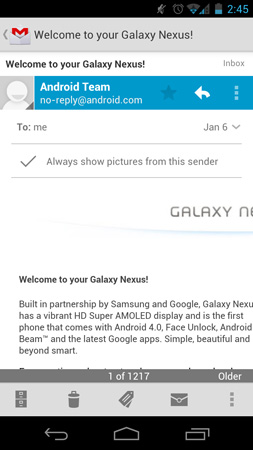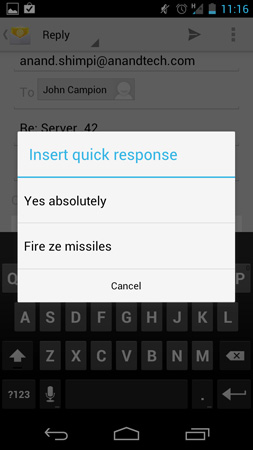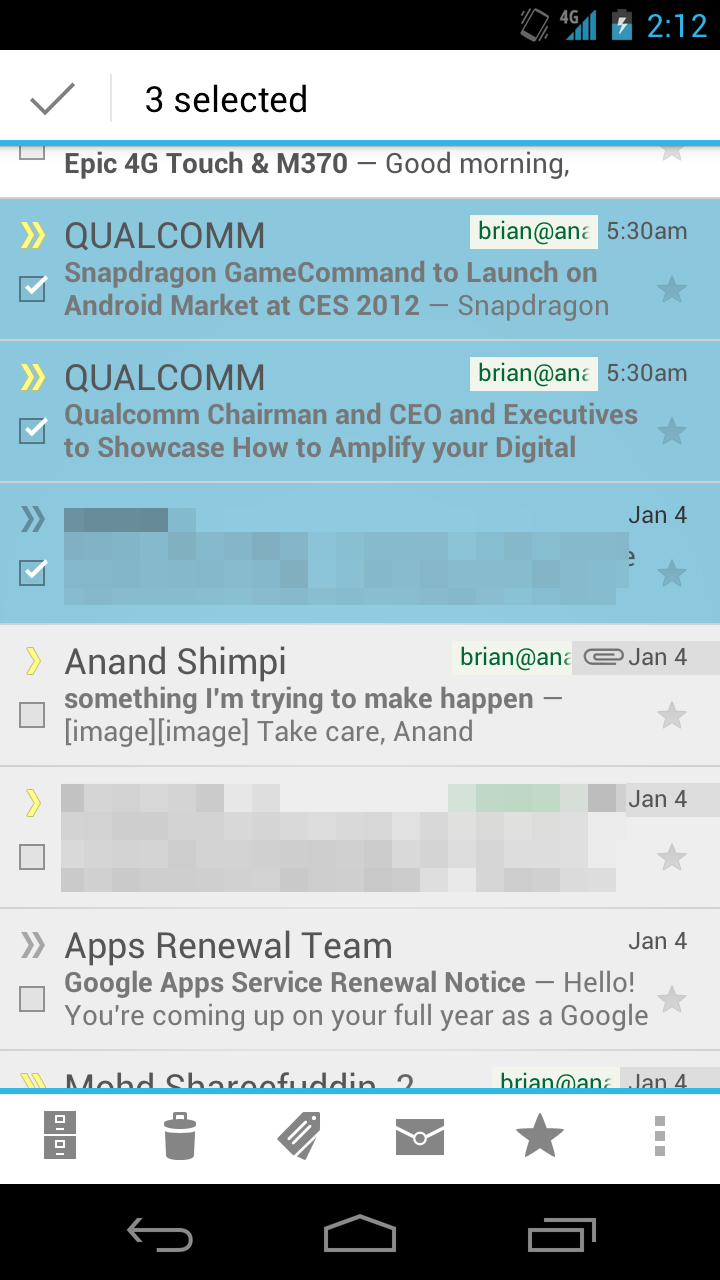Samsung Galaxy Nexus & Ice Cream Sandwich Review
by Brian Klug & Anand Lal Shimpi on January 18, 2012 1:34 PM ESTThe standard Email app in ICS is an evolutionary improvement over what we saw in Gingerbread. The white text on a black background is now inverted to a much more modern looking black text on white background theme:

The UI and performance improvements give the email app a nice update, but there are some feature enhancements as well.
You can still select several emails at a time for starring, marking, moving or deleting. ICS no longer requires you to hit a menu button to bring up additional options or even to do something as simple as composing an email. All of the most commonly used functions are displayed at the bottom of the screen.
Deleting emails is still not as instantaneous as I'd like it. If you're deleting a small number of emails they'll all go at once after a bit of a delay, otherwise for long lists you'll see the emails slowly disappear.
In message view mode you can quickly reply to any message by tapping the reply arrow key, however to reply to all or forward a message you'll need to first hit the contextual menu button at the top of the screen (this is configurable, you can make reply to all the default action).
Quoted text in a reply is still neatly placed in a separate text box, which keeps your composition text box nice and clean. ICS adds support for quick replies, which are canned responses to emails that you define manually and can quickly insert.


Server side searching is finally supported, however it's fairly slow (slower than iOS at least). String matching in your search query also seems to be fairly strict so you'll have to make sure that the word(s) you're searching for are not immediately preceded/followed by other characters. You also can't specify where in the email (subject, address field, message text, etc...) you want to search, you just get a general search box.
Gmail
Among the other first-party applications that are new in Android 4.0 is Gmail, which receives an overhaul that closely matches the client from 3.x. The update includes a dramatic makeover that minimizes use of the menu button for interaction. Instead, there’s a row of icons along the bottom for refreshing, composing, searching, and tagging Gmail conversations. If you make selections this row of buttons changes appropriately to mark read/unread and archive/trash items as well. At the very top is a drop down pane for selecting the current label or other inboxes.
On a smartphone sized device, Gmail now looks and feels a lot like the client from Android 3.x, except with menu and organizing befitting a smartphone. The improvement is dramatic and manages to leave the 2.x client feeling old and unintuitive. The only unfortunate thing is that in the message view, Gmail still lacks pinch to zoom functionality, making looking at emails composed with lots of HTML difficult. This is something that people have been vocal about since the Gmail in Android 2.x which surprisingly still is present.
Minor gripes aside, the Android Gmail application in 4.x yet again sets the bar for the best native Gmail implementation. I can’t go back to the 2.x client, and in comparison the iOS Gmail client seems like a cheap facsimile.












185 Comments
View All Comments
zorxd - Thursday, January 19, 2012 - link
And what exactly is more efficient?c4v3man - Thursday, January 19, 2012 - link
Their implimention of pseudo-multitasking as opposed to the much more flexible multitasking in Android.erple2 - Friday, January 20, 2012 - link
Bingo!Since the iOS can't do "true" multitasking, primarily as a design decision on Apple's part to greatly improve battery life (seen the battery life numbers on WebOS? They're pretty terrible), the requirements for memory are generally quite a bit lower than for Android.
You could argue all day as to which one is better, and still not come up with a clear winner. This is strictly due to the phone form factor. Given the limitations on usable screen size (can't display 2 apps at once reliably), and that you have to rely on battery life, the argument of which is "better" is more difficult to make. These all disappear when power is no longer a serious concern (desktop), nor physical screen display (notebook through desktop).
zorxd - Friday, January 20, 2012 - link
yeah and DOS is better because it works fine with only 1MB RAM.OCedHrt - Friday, January 20, 2012 - link
Which is fine due to fast app switching.trob6969 - Wednesday, January 18, 2012 - link
You didn't have to sacrifice GPU performqnce for a 4.3 inch 720p HD display. You could have done what i did and got an htc rezound. I downloaded Dead space, which is probably one of the most GPU demanding games for a phone, and gameplay is FLAWLESS on it! ZERO choppiness throughout the game. My rezound plays this game just as smoothly as my playstation 3. That says a lot about a phone's performance.metafor - Wednesday, January 18, 2012 - link
Note that with the increased clockspeed to the SGX540, the OMAP4460 matches the GPU performance of a Snapdragon S3 (used in the Rezound).Both chips perform similarly with the CPU clock at 1.2GHz (compare Sensation 4G to GN, for example).
dwang - Wednesday, January 18, 2012 - link
Deadspace runs perfectly fine on the galaxy nexus. No choppiness or slowdown.Zoomer - Thursday, January 19, 2012 - link
TI probably didn't anticipate the move to such high resolutions. The 540 was probably chosen as a good enough solution, given the power reqs are well.This is where Apple's hardware-software codesign wins out.
Johnmcl7 - Wednesday, January 18, 2012 - link
That reasoning that microSD cards are too slow seems to only apply to some of the cheap phones which pretty only use micro SD storage, for a phone like the Nexus it doesn't matter as you say because the micro SD card is for storage rather than applications. I don't really understand why the Nexus doesn't get a harder time for the lack of microSD storage given the relatively low onboard storage and high spec which means it can play back high resolution video which needs quite a bit of space. It's one of the main reasons I went for the Note instead which has the better camera, faster GPU and the micro SD storage allowing me to add 32GB very cheaply (and more down the line when 64GB cards come down in price) which is pretty necessary as the high resolution video recording and other features chew through space very quickly.John